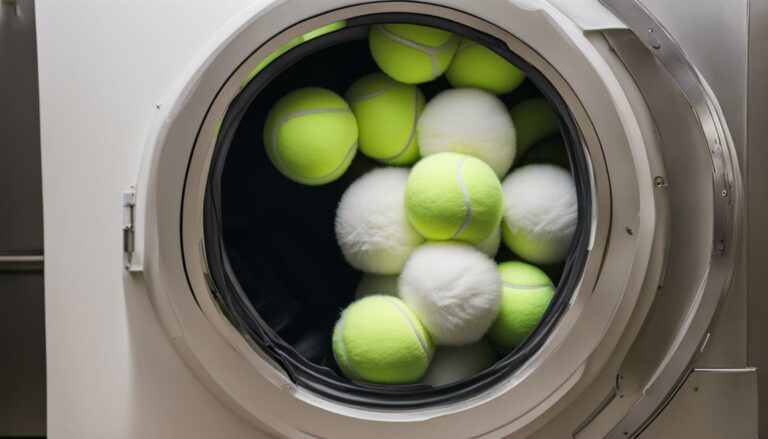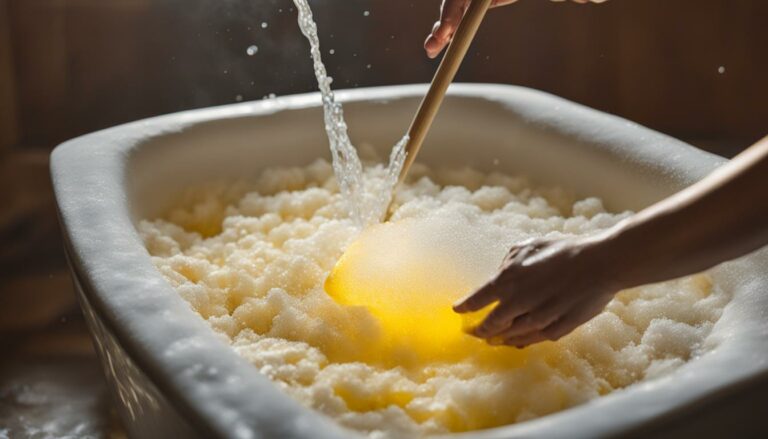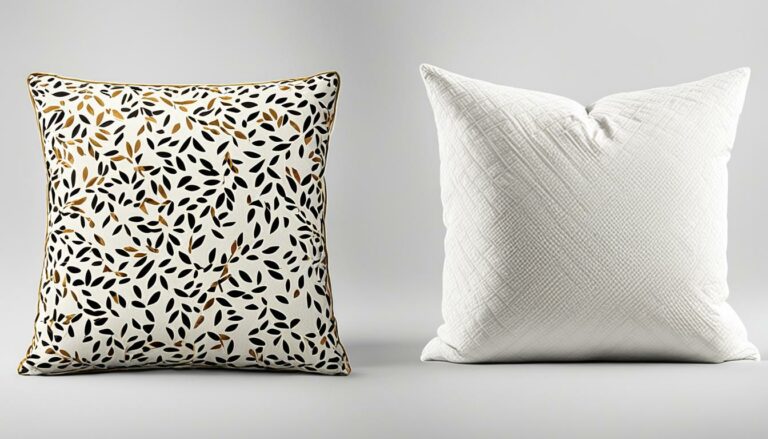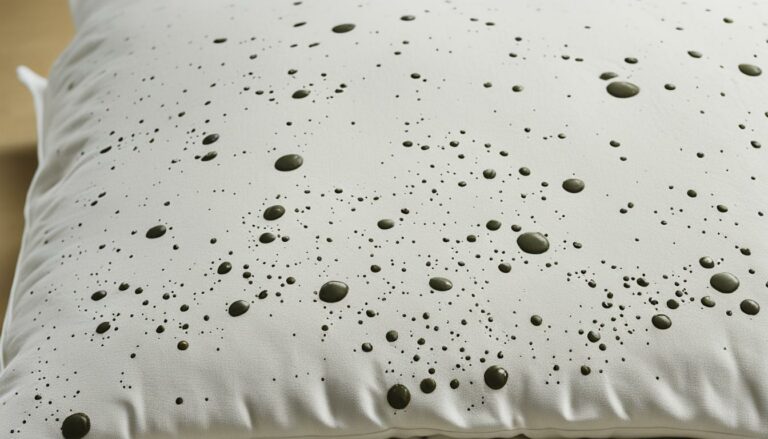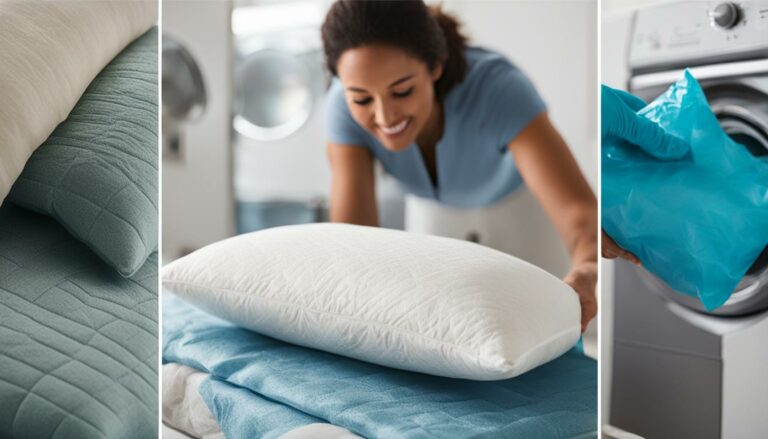Dry Your Pillow Safely – Can I Put My Pillow in the Dryer?
Eric Christie stands as a luminary in the bedding industry, with a career spanning nearly four decades since the early 1980s. His journey through the world of bedding has seen him wear many hats – a manufacturer, designer, and retailer, showcasing his versatility and expertise in Read more...
pillowsandbedsheets.com and its partners may earn a commission if you purchase a product through one of our links
Pillows provide us with comfort and support as we rest, but they can also accumulate dirt, dust, sweat, bacteria, and even mold or mildew over time. That’s why it’s important to clean and dry them regularly to maintain their freshness and longevity. In this article, we will explore the proper way to dry your pillow without causing any damage, and answer the common question, “Can I put my pillow in the dryer?”
Key Takeaways:
- Regularly washing and drying pillows helps maintain their freshness and support.
- Drying pillows offers several benefits, including fluffing the fill, removing dust and allergens, and naturally disinfecting them.
- Properly preparing your pillows for drying involves vacuuming and washing them according to the care instructions.
- Down and feather pillows can be dried in the dryer using a medium heat setting and dryer balls.
- Polyester and down alternative pillows should be dried on a low heat setting with dryer balls.
The Benefits of Drying Your Pillows
Drying your pillows offers several benefits. It helps fluff the fill, making the pillows feel brand new. Drying also removes excess dust, allergens, and tangled hair from the pillows. Additionally, drying your pillows can freshen your linens and naturally disinfect them. The heat from the dryer or sunlight helps kill bacteria and remove odors.
How to Prepare Your Pillows for Drying
Before drying your pillows, it is important to prepare them properly. Follow these steps to ensure your pillows are clean and ready for drying:
- Vacuuming: Start by vacuuming the pillows to remove any dust or debris. Use a handheld vacuum or the upholstery attachment on your vacuum cleaner to thoroughly clean both sides of the pillow. Pay special attention to the seams and edges, where dust and dirt tend to accumulate.
- Washing: Next, wash the pillows according to the care instructions. Use a mild detergent and select the appropriate water temperature for your pillow type. If your pillows have stubborn stains, spot-treat them with a stain remover or a mixture of baking soda and water before washing.
By vacuuming and washing your pillows before drying, you ensure that they are free from dust, debris, and stains, allowing for a more effective and hygienic drying process.
“Properly preparing your pillows for drying is crucial to ensure cleanliness and maintain their quality.”
| Pillow Preparation Steps | Description |
|---|---|
| Vacuuming | Use a vacuum cleaner or handheld vacuum to remove dust and debris from the pillows. Pay attention to seams and edges. |
| Washing | Follow the care instructions and use a mild detergent to wash the pillows. Spot-treat any stains before washing. |
Drying Down and Feather Pillows
If you have down or feather pillows, you’ll be glad to know that they can be safely dried in the dryer. To achieve the best results, follow these steps:
- Set your dryer to a medium heat setting.
- Add dryer balls or tennis balls to the dryer along with your pillows.
- Start the dryer and let it run until the pillows are completely dry.
Note: Dryer balls or tennis balls help to agitate the pillows, preventing clumping and helping to fluff the feathers or down.
Drying down and feather pillows in the dryer not only removes moisture but also helps to maintain their loft and shape for long-lasting comfort.
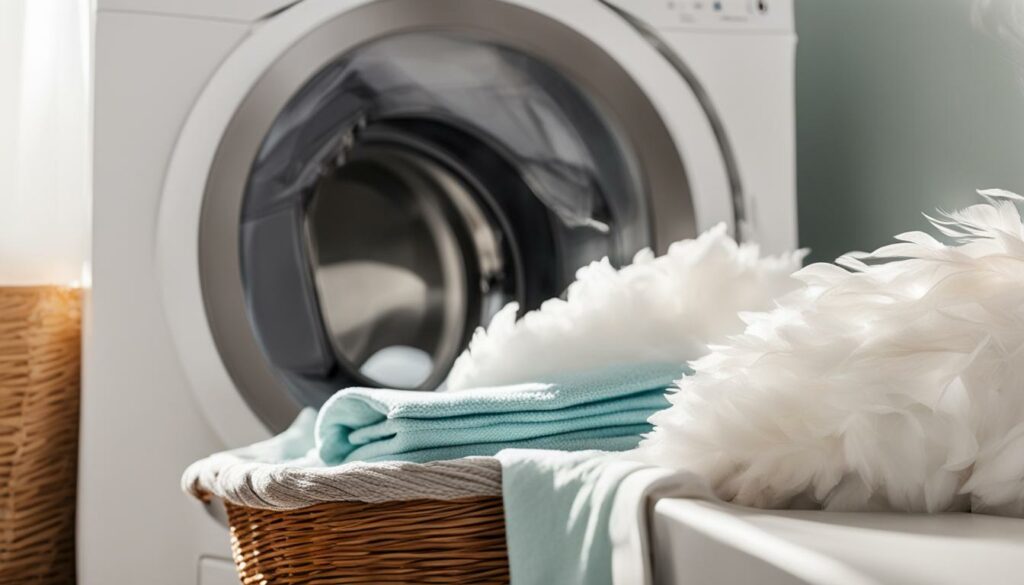
Why use dryer balls?
Dryer balls are small, solid balls made of rubber or fabric that improve air circulation in the dryer. They work by separating the pillows and preventing them from sticking together, resulting in even drying and fluffier pillows.
Drying Polyester and Down Alternative Pillows
When it comes to drying polyester pillows and down alternative pillows, it’s important to take the right steps to prevent clumping and maintain their fluffiness. Follow these guidelines to ensure your pillows come out perfectly dry and ready to use.
First, set your dryer to a low heat setting. This will prevent the pillows from overheating and potentially damaging the polyester or down alternative filling.
Next, add dryer balls or tennis balls to the dryer. These balls help agitate the pillows during the drying process, preventing them from clumping and ensuring the filling is evenly distributed.
If you don’t have dryer balls, you can also use clean tennis shoes or soft towels. The important thing is to have something that will separate and fluff the pillows as they dry.
Alternatively, you can also choose to air-dry your polyester or down alternative pillows. Simply lay them flat on a clean surface or hang them in a well-ventilated area. Make sure to flip them occasionally to ensure even drying.
Remember, whether you opt for the dryer or air-drying method, the key is to avoid high heat that can damage the pillows. Low heat or natural drying methods are the way to go for safe and effective drying.
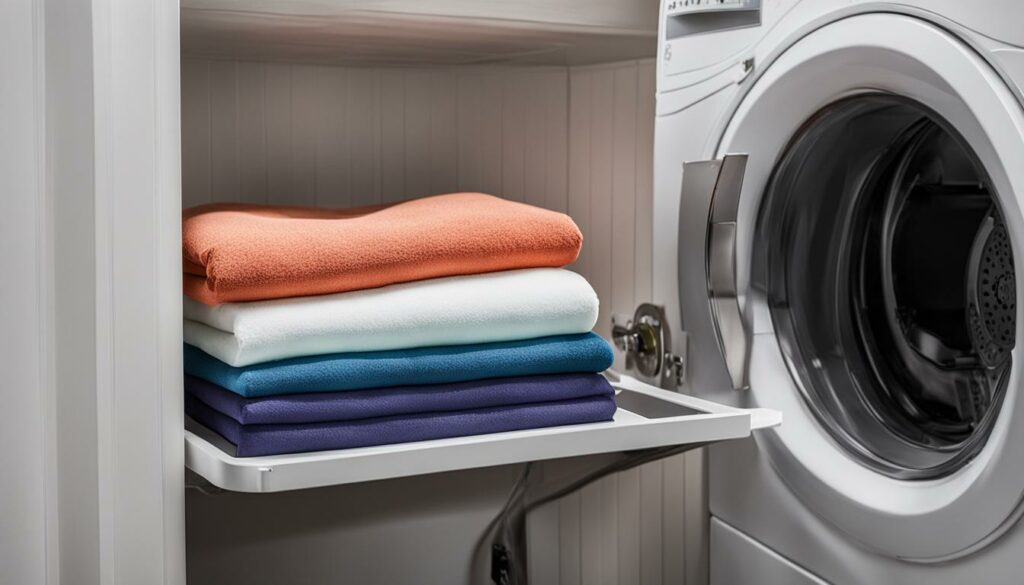
Note: Using the appropriate drying method for your pillows will help them maintain their shape, fluffiness, and overall quality over time.
Drying Memory Foam and Latex Pillows
When it comes to drying memory foam and latex pillows, it’s important to avoid using a dryer. The heat from the dryer can damage these materials, affecting their support and overall quality. Instead, opt for air-drying methods to ensure the longevity of your pillows.
One method for air-drying memory foam and latex pillows is to lay them flat in a well-ventilated area. Place a clean towel underneath to absorb any excess moisture. This ensures that the pillows dry evenly and prevents any potential mold or mildew growth.
To further facilitate the drying process, it’s recommended to flip the pillows occasionally. This allows for consistent airflow and helps expedite the drying time. Remember to check the pillows periodically to ensure they are drying properly and to adjust their position if necessary.
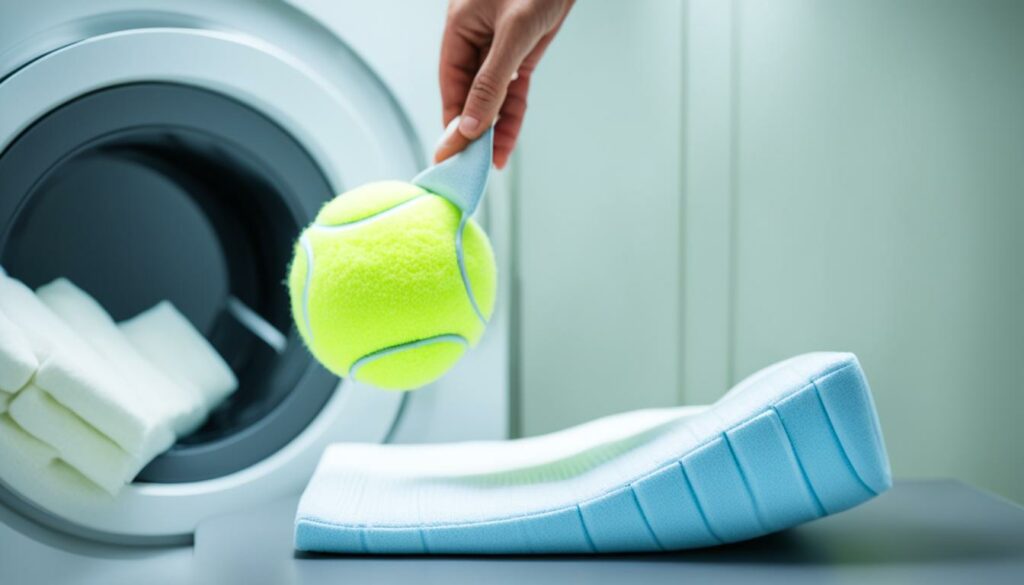
Another option for air-drying memory foam and latex pillows is to hang them in a well-ventilated area. Use a clothesline or a sturdy hanger to hang the pillows up, ensuring they are evenly distributed. This method allows for optimal airflow and ensures thorough drying.
Regardless of the method you choose, make sure the pillows are completely dry before using them again. Moisture can lead to the growth of mold, mildew, and bacteria, which can impact both the hygiene and quality of your pillows.
Remember, air-drying is the safest and most effective way to dry memory foam and latex pillows. By following these steps, you can ensure that your pillows maintain their comfort, support, and longevity.
Natural Disinfecting and Sun Drying
Sun drying pillows can act as a natural disinfectant, harnessing the power of UV rays to kill bacteria and eliminate odors. When you place your pillows in direct sunlight for a few hours, the UV rays penetrate the fabric, effectively removing harmful bacteria and leaving your pillows fresh and clean.
It’s important to note that while sun drying can effectively disinfect the surface of your pillows, it may not thoroughly disinfect the inside. Therefore, it’s recommended to combine sun drying with regular washing or other disinfection methods for a more comprehensive cleaning.
To harness the natural disinfecting power of the sun, follow these simple steps:
- Choose a sunny day: Pick a clear day with ample sunlight to ensure effective disinfection.
- Find a suitable spot: Place your pillows in a location where they can receive direct sunlight for several hours. A spacious outdoor area, such as a backyard or patio, is ideal.
- Position pillows correctly: Lay the pillows flat on a clean surface or hang them using a clothesline or hanger. Make sure they are fully exposed to the sunlight.
- Rotate pillows: To ensure even disinfection, periodically rotate the pillows to expose all sides to the sun’s rays.
- Leave pillows to sun dry: Allow your pillows to sit in the sun for at least a few hours. The longer they are exposed to sunlight, the more effective the disinfection process.
Remember that sun drying not only helps remove bacteria but also eliminates odors, leaving your pillows smelling fresh and pleasant.
Tips for Proper Pillow Care
To keep your pillows in good condition, follow these tips for optimal pillow care:
- Regularly fluff your pillows: Fluffing your pillows on a regular basis helps to remove dust and maintain their shape. Simply give them a good shake and fluffing to distribute the filling evenly.
- Consider alternative cleaning methods for foam pillows: Foam pillows should not be washed in the machine as it can damage the material. Instead, use a vacuum cleaner to remove any surface dust and dirt. If necessary, sprinkle a small amount of cornstarch over the pillow to absorb oils and odors, then vacuum it up after 15 minutes.
- Use removable pillow protectors: Investing in removable pillow protectors is a great way to safeguard your pillows from stains, spills, and allergens. Make sure to choose protectors that are machine washable and wash them monthly to keep them fresh and clean.
- Replace your pillows every two years: Over time, pillows lose their support and accumulate allergens, dust mites, and bacteria. It is recommended to replace your pillows every two years or when they no longer provide adequate support. If your pillows develop stains that cannot be removed or have an unpleasant odor, it is a sign that they need to be replaced.
By following these pillow care tips, you can extend the lifespan of your pillows, maintain their cleanliness, and ensure a comfortable sleep environment.
Frequently Asked Questions about Drying Pillows
If you have questions about drying pillows, we’ve got answers! Check out these frequently asked questions to learn more about the best practices for drying your pillows.
1. Can I safely put my pillows in the dryer?
Yes, you can safely put certain types of pillows in the dryer. Feather, down, polyester, and down alternative pillows are usually dryer-safe. However, memory foam and latex pillows should never be placed in the dryer, as the heat can damage these materials.
2. How do I dry memory foam pillows?
Memory foam pillows should be air-dried to maintain their shape and quality. Lay them flat on a clean surface or hang them in a well-ventilated area. Remember to flip the pillows occasionally to ensure even drying.
3. How often should I dry my pillows?
The frequency of drying your pillows depends on factors such as how frequently they are used and personal preference. As a general guideline, aim to dry your pillows every few months to keep them fresh and clean. However, if your pillows have absorbed excess moisture or have developed an odor, it’s a good idea to dry them more frequently.
4. What are some tips for effective pillow drying?
- Use a low heat setting when drying polyester and down alternative pillows to prevent clumping.
- Add dryer balls or tennis balls to the dryer to help fluff the pillows and prevent clumping.
- Air-dry memory foam and latex pillows to avoid damage from heat.
5. Can sun drying disinfect my pillows?
Sun drying can act as a natural disinfectant for pillows, as the UV rays help kill bacteria and remove odors. However, keep in mind that the inside of the pillows may not be thoroughly disinfected through this method. Letting the pillows sit in direct sunlight for a few hours can provide some benefit.
6. How can I maintain the quality of my pillows?
To maintain the quality of your pillows, follow these tips:
- Regularly fluff your pillows to remove dust and keep them feeling fresh.
- For foam pillows, avoid washing and instead use cornstarch or vacuum them to remove dirt and oils.
- Use removable pillow protectors and wash them monthly to keep your pillows clean.
- Consider replacing your pillows every two years or when they lose support or develop stains that cannot be removed.
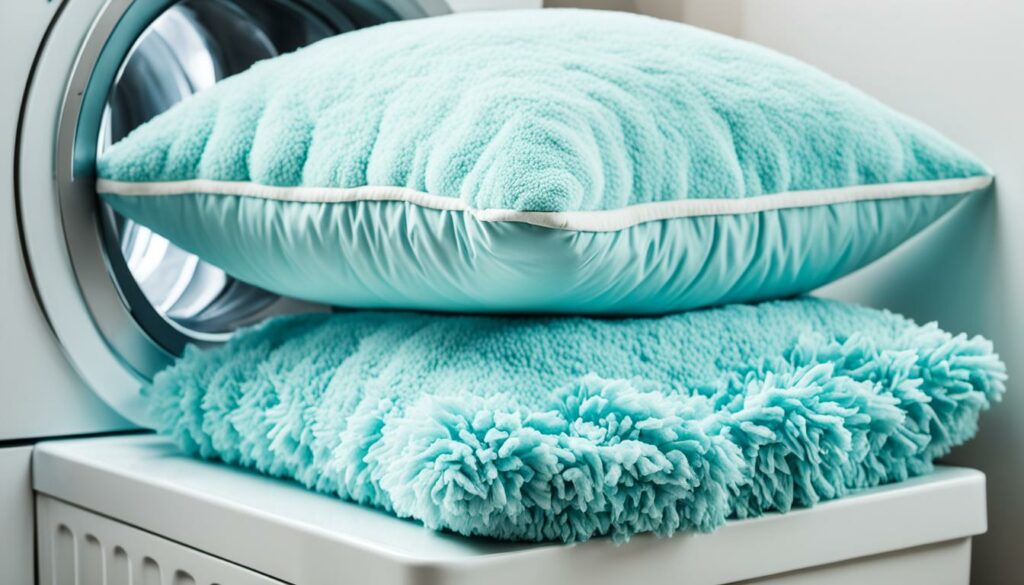
“Proper drying techniques can help prolong the life of your pillows and maintain their comfort. Remember to follow the specific care instructions for your pillow type to ensure the best results.”
Conclusion
Drying your pillows properly is essential for maintaining their quality and prolonging their lifespan. Whether you choose to dry them in the dryer or air-dry them, following the appropriate methods for each pillow type will help keep them clean, fresh, and comfortable. By taking care of your pillows, you can create a healthier sleeping environment and enjoy a good night’s rest.
Tips for Proper Pillow Care:
- Regularly fluff your pillows to remove dust and maintain their shape.
- For foam pillows, use cornstarch or vacuum them instead of washing.
- Use removable pillow protectors and wash them monthly to keep your pillows clean.
- Replace your pillows every two years or when they lose support or develop stains that cannot be removed.
“Taking care of your pillows ensures a comfortable and healthy sleep environment.”
Proper pillow care involves regular maintenance and attention to detail. By following the steps outlined in this article, you can extend the life of your pillows and ensure they provide optimal comfort and support. Remember to consult the care instructions specific to your pillows and adapt the drying methods accordingly. With the right care, your pillows will stay fresh, clean, and ready for a good night’s sleep.
Resources and References
If you’re looking for more information on drying pillows and proper pillow care, the following resources and references can provide valuable insights:
– Pillow Drying Resources: Check out websites like PillowTalk and Pillowpedia for detailed articles and guides on pillow drying techniques. These resources offer step-by-step instructions and tips to help you dry your pillows effectively without damaging them.
– Pillow Care References: The Pillow Care Association’s website is a great reference for all things related to pillow care. They provide comprehensive information on cleaning, drying, and maintaining different types of pillows, ensuring longevity and optimal sleep quality.
– Drying Pillows Articles: HealthHomeLiving and SleepWise are renowned platforms that publish informative articles on pillow care. Explore their archives for articles specifically on drying pillows, with expert advice and recommendations on the best methods for different pillow materials.
By referring to these valuable resources and references, you can enhance your knowledge on pillow care and learn effective pillow drying techniques that will help you extend the life and comfort of your pillows.
FAQ
Can I put my pillow in the dryer?
Yes, you can put certain pillows, such as down and feather pillows, in the dryer. However, it is important to use a medium heat setting and add dryer balls or tennis balls to help fluff the pillows and prevent clumping.
How do I dry memory foam pillows?
Memory foam pillows should not be put in the dryer, as the heat can damage the material. Instead, air-dry these pillows by laying them flat or hanging them in a well-ventilated area.
How often should pillows be dried?
Pillows should be dried regularly to maintain their freshness and support. It is recommended to dry your pillows every few months, or as needed, to ensure they are clean and free from dust, allergens, and odors.
What are the benefits of drying pillows?
Drying pillows helps fluff the fill, removes excess dust and allergens, freshens linens, and acts as a natural disinfectant by killing bacteria and removing odors.
How do I prepare my pillows for drying?
Start by vacuuming the pillows to remove any dust or debris. Next, wash the pillows according to the care instructions, spot-treating any stains beforehand. This will ensure that the pillows are clean and ready for drying.
How do I dry polyester and down alternative pillows?
Polyester and down alternative pillows should be dried on a low heat setting to prevent clumping. It is essential to use dryer balls or tennis balls to agitate the pillows and fluff the filling. Alternatively, air-drying these pillows can also be an option to avoid clumping.
How do I sun dry pillows?
Sun drying pillows can act as a natural disinfectant. Place the pillows in direct sunlight for a few hours to benefit from the UV rays that help kill bacteria and remove odors. However, note that the inside of the pillows may not be fully disinfected using this method alone.
What are some tips for proper pillow care?
Regularly fluff your pillows to remove dust, consider using cornstarch or vacuuming foam pillows instead of washing them, use removable pillow protectors and wash them monthly, and replace your pillows every two years or when they lose support or develop stains that cannot be removed.
What are some frequently asked questions about drying pillows?
Here are some common questions about drying pillows: Can I put my memory foam pillow in the dryer? How long does it take to dry a pillow? Can I dry my pillow in the sun? Is it safe to use dryer balls on all types of pillows?
(Note: The following sections, “Conclusion” and “Resources and References,” are not part of the FAQ and should be excluded from this section.)
Eric Christie stands as a luminary in the bedding industry, with a career spanning nearly four decades since the early 1980s. His journey through the world of bedding has seen him wear many hats – a manufacturer, designer, and retailer, showcasing his versatility and expertise in Read more...


